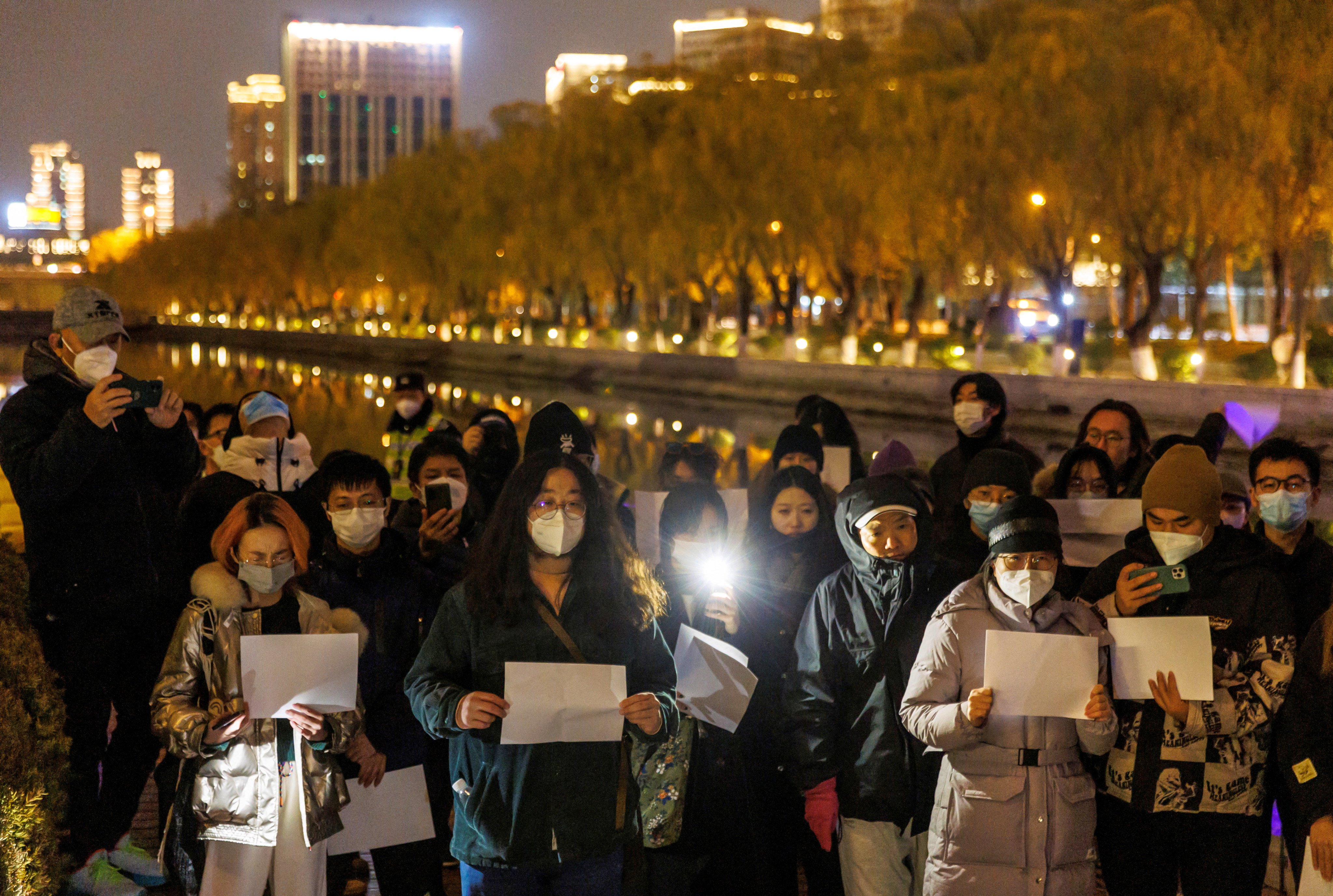www.aljazeerah.info
Opinion Editorials, December 2022
Archives
Mission & Name
Conflict Terminology
Editorials
Gaza Holocaust
Gulf War
Isdood
Islam
News
News Photos
Opinion Editorials
US Foreign Policy (Dr. El-Najjar's Articles)
www.aljazeerah.info
As Costs of 'Zero Covid' Mount, China's Economy Needs Urgent Rescue By Fang Zihao SCMP, December 1, 2022 |
 |
 |
|
| Protests against Covid-19 restrictions in China, November 28, 2022 |
The emergence of Omicron has rendered its ‘zero Covid’ strategy uneconomical and unsustainable, and China must reopen its struggling economy This means preparing its healthcare system for a surge in cases, and easing its monetary policy to boost confidence and consumption
An aircraft ground personnel wearing a protective suit looks at a phone as passengers prepare to board an aircraft at the Beijing Capital International Airport in Beijing on November 30. The welfare loss from the zero-Covid strategy now greatly exceeds that of a strategy of living with the virus. Photo: EPA-EFE
Globally, many countries have now fully reopened amid the Covid-19 pandemic. China’s implementation of the “zero-Covid” strategy during the Delta wave provided a competitive advantage for development. However, now that Omicron and its variants are dominant and are expected to remain so for the foreseeable future, China should revisit its zero-Covid policy.
In the EU, Britain and the US, where economies have completely reopened, the average excess mortality rate for this year is estimated to be less than 10 per cent. If the same applies to China, a policy shift to reopen could result in up to 1 million additional deaths per year.
If we take the estimated average value of a statistical life in China to be about 2.2 million yuan (US$309,000), based on various research, the loss caused by Covid-19 deaths every year would reach at most 2 trillion yuan, or 2 per cent of China’s gross domestic product (GDP).
This number might be an overestimation of the losses as most patients dying from the Omicron variant are more than 80 years old and their life expectancy is significantly shorter. There are not many credible studies on the quality-adjusted life-year losses per Omicron infection. But if based on the data from the Delta wave, the total welfare loss from Omicron, including death and long Covid, would be around 1 per cent of China’s GDP.
On the other hand, China’s potential growth rate was projected around 5.2 per cent this year, but its actual economic growth rate is expected to be around 3.2 per cent. This translates to an economic loss from the zero-Covid strategy of about 2 per cent of GDP.
In addition, this number does not account for government spending to enforce mass testing, lockdowns and other preventive measures. Therefore, the welfare loss from the zero-Covid strategy greatly exceeds that from the “living with Covid-19” strategy.
Since China cannot eradicate the virus on its own, it will incur a net welfare loss each year in the future if the current policy persists. This is a deadweight loss. Accordingly, China should adjust its Covid-19 strategy.
Before that, China should prepare in numerous areas for a post-reopening surge in cases. The government should purchase ventilators and other therapeutic equipment in volume. Chinese vaccine manufacturers could seek partnerships with firms such as BioNTech to produce mRNA vaccines domestically and apply for a domestic use authorisation. Concurrently, China should promote universal booster injections for the elderly.
China’s economy is struggling. Continued lockdowns and other policy overkill have damaged the country’s economic resilience. Its GDP growth rate is far below the potential level, domestic consumption growth is weak, youth unemployment is near 20 per cent and core consumer inflation stands at only 0.6 per cent.
In the meantime, China’s seven-day pledged repo rate remains above 1.8 per cent, significantly higher than current core inflation expectations. To prevent a deflationary spiral, the central bank needs to introduce a more accommodative policy.
Some worry a rate cut in China will hasten yuan depreciation. This will not happen since its depreciation stems from a lack of confidence in the Chinese economy rather than the divergence of monetary policy between China and the US. Unlike the euro and the yen, which have depreciated throughout much of the year, the yuan was among the world’s strongest currencies before the lockdowns in April but has been one of the weakest since then.
Cutting interest rates will restore economic confidence because it will reduce the financial pressure on the household and corporate sectors and increase households’ willingness to consume and firms’ willingness to invest. This will boost China’s domestic demand and economic growth as well as strengthening the yuan.
The most significant effect of cutting interest rates will be stabilising expectations in the property market. Plunging home prices have and will continue to shake domestic economic confidence.
As many consumers expect continued drawdowns in their wealth, they hesitate to spend. Some also might sell their properties and leave the country, lowering public expectations of the yuan exchange rate.
When implementing an accommodative policy, the central bank must also monitor the market to avoid excessively accommodative policies that push up domestic house prices, which are already high compared to other countries.
Growing anger over China’s unfinished ‘rotten tail’ buildings: ‘We really need this home’
US demand growth is likely to be mediocre next year, and China is already too large to be driven by foreign demand. Therefore, most private businesses will look at domestic consumption and then make investment decisions.
Investment by state-owned enterprises (SOEs) or in infrastructure could increase short-term growth rates, but it would lead to the accumulation of unsustainable debt and further diminish long-term growth potential. Domestic consumption must be fast enough to drive private investment, pushing economic growth to its potential.
In this context, reforms once considered unnecessary or remote – such as mixed-ownership reform in SOEs, raising SOE dividend payout levels, streamlining government agencies and establishing a more effective social safety net – have become increasingly pressing.
The emergence of Omicron has rendered the zero-Covid strategy uneconomical and unsustainable. China needs to prepare to transition to reopening. Since the balance sheets of households and firms have deteriorated, monetary policy needs to be more accommodative to prevent short-term asset price turmoil and lack of economic confidence from escalating into long-term consumption contraction and economic stagnation.
***Fang Zihao is currently studying for a Ph. D. in economics at Koc University in Istanbul. His main research interests include the middle-income trap, innovation mechanisms, and the relationship between them. He also follows the latest developments in the global financial markets.
***
Share the link of this article with your facebook friends
|
|
|
|
||
|
||||||


